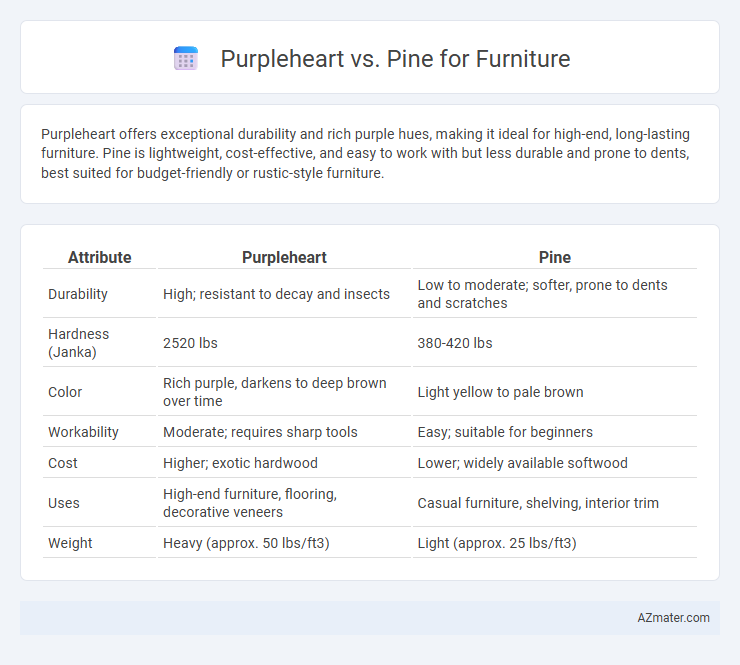Purpleheart offers exceptional durability and rich purple hues, making it ideal for high-end, long-lasting furniture. Pine is lightweight, cost-effective, and easy to work with but less durable and prone to dents, best suited for budget-friendly or rustic-style furniture.
Table of Comparison
| Attribute | Purpleheart | Pine |
|---|---|---|
| Durability | High; resistant to decay and insects | Low to moderate; softer, prone to dents and scratches |
| Hardness (Janka) | 2520 lbs | 380-420 lbs |
| Color | Rich purple, darkens to deep brown over time | Light yellow to pale brown |
| Workability | Moderate; requires sharp tools | Easy; suitable for beginners |
| Cost | Higher; exotic hardwood | Lower; widely available softwood |
| Uses | High-end furniture, flooring, decorative veneers | Casual furniture, shelving, interior trim |
| Weight | Heavy (approx. 50 lbs/ft3) | Light (approx. 25 lbs/ft3) |
Introduction: Purpleheart vs Pine for Furniture
Purpleheart and pine are two popular wood choices for furniture, each offering unique characteristics that influence durability and aesthetics. Purpleheart is known for its rich, vibrant purple hue and exceptional hardness, making it ideal for high-traffic or statement pieces. Pine, a softwood, is prized for its affordability, light color, and ease of working, but it is more susceptible to dents and scratches compared to dense hardwoods like purpleheart.
Wood Characteristics: Purpleheart and Pine
Purpleheart wood is renowned for its exceptional durability, rich purple hue that deepens over time, and high resistance to decay and insect damage, making it ideal for high-end furniture with a striking appearance. Pine, a softwood, is lighter and more affordable but less durable, prone to dents and scratches, and features a pale yellow color with distinct knots that appeal to rustic or casual styles. The dense grain of Purpleheart yields a smooth, fine finish, contrasting with Pine's softer, more porous texture that easily takes stains and paints.
Durability and Strength Comparison
Purpleheart wood exhibits exceptional durability and strength, with a Janka hardness rating of approximately 2,520 lbf, making it significantly harder and more resistant to wear than Pine, which has a Janka rating around 420 lbf. Its dense, interlocking grain structure provides superior resistance to dents, scratches, and decay, ideal for high-traffic furniture pieces. Pine, being a softer and less dense wood, is more prone to dents and scratches, and requires more maintenance to ensure longevity in furniture applications.
Appearance and Aesthetic Appeal
Purpleheart wood boasts a striking deep purple hue that darkens over time to a rich brownish-purple, making it a distinctive choice for furniture with bold visual impact. Pine features a lighter, warm tone with natural knots and a softer grain pattern, lending a rustic and cozy aesthetic ideal for casual or country-style decor. The dramatic color and durability of purpleheart contrast with pine's understated charm and versatility, allowing each to suit different design preferences and interior themes.
Workability and Ease of Use
Purpleheart wood is dense and hard, making it challenging to saw, drill, and sand but providing excellent durability for furniture. Pine is soft and lightweight, offering superior workability, easy cutting, shaping, and finishing, ideal for beginner woodworkers. Despite Pine's ease of use, Purpleheart's striking color and resistance to wear make it a valuable choice for long-lasting, visually distinctive furniture pieces.
Cost and Availability
Purpleheart is significantly more expensive than pine due to its exotic origin and limited supply, often costing several times more per board foot. Pine is widely available and inexpensive, making it a popular choice for budget-friendly furniture projects. The rarity of Purpleheart also means longer lead times and restricted availability compared to the abundant and easy-to-source pine lumber.
Environmental Impact and Sustainability
Purpleheart wood, sourced from sustainably managed South American forests, offers a durable and dense option that reduces the need for frequent replacement, thus minimizing environmental impact over time. Pine is widely available and fast-growing, making it a renewable resource with lower carbon sequestration potential but typically requires chemical treatments that may affect its ecological footprint. Choosing Purpleheart supports biodiversity preservation due to its selective harvesting practices, while Pine's rapid growth cycle ensures quicker reforestation and carbon capture when responsibly managed.
Maintenance and Longevity
Purpleheart wood offers exceptional durability and resistance to decay, making it highly suitable for long-lasting furniture with minimal maintenance. Pine requires more frequent upkeep due to its softer nature and susceptibility to dents, scratches, and moisture damage. Regular sealing and careful handling extend pine furniture's lifespan, while purpleheart's dense grain and hardness naturally protect against wear and environmental factors.
Best Applications for Purpleheart and Pine
Purpleheart wood, known for its vibrant purple hue and exceptional durability, is ideal for high-end furniture pieces requiring strength and visual impact, such as tabletops, flooring, and decorative veneers. Pine, a softer and lighter wood, is best suited for casual furniture, cabinetry, and indoor items where affordability and ease of work are essential. Both woods offer distinct advantages: Purpleheart excels in longevity and unique appearance, while Pine provides versatility and cost-effectiveness for everyday furniture applications.
Conclusion: Which Wood is Best for Your Furniture?
Purpleheart offers exceptional durability and striking color, making it ideal for high-end furniture that demands both strength and visual appeal. Pine provides affordability and ease of workability, suited for budget-friendly or rustic-style furniture pieces. Choose Purpleheart for long-lasting, vibrant furniture or Pine for cost-effective, lightweight designs with classic charm.

Infographic: Purpleheart vs Pine for Furniture
 azmater.com
azmater.com